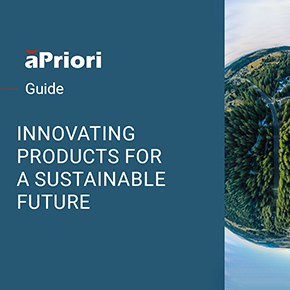How to Use Life Cycle Assessments in the Product Design Process
Key Takeaways:
- Life cycle assessment (LCA) tools report on products’ cradle-to-grave carbon footprint
- Manufacturers are complementing LCA tools with product design sustainability insights
- aPriori empowers companies to bring low-carbon products to market rapidly and profitably
The Full Article:
Life cycle assessment (LCA) software, coupled with expert analysis, provides powerful “cradle-to-grave” reports on a product’s environmental impact. Although LCA software provides granular sustainability data, project teams typically do not have access to these insights or cannot access them quickly during the early product design process. Consequently, companies are missing the opportunity to use LCAs during the critical product design process, which determines 80% of products’ overall embedded carbon.
Forward-thinking manufacturers are closing the gap with automated product design sustainability insights software that uses end-to-end digital twins to unlock cost, carbon, and manufacturability metrics. Organizations gain the transparent, rapid carbon dioxide equivalent (CO2e) insights needed to achieve profitability and sustainability goals quickly and confidently. These “cradle-to-gate” carbon insights are at the product level and can be incorporated into manufacturers’ broader LCA assessments.
Outcomes of Lacking Early Design-Stage Carbon Visibility
Organizations lacking early, real-time visibility into product carbon may find it nearly impossible to iterate designs quickly to minimize environmental impacts. LCAs cover a product’s overall environmental impact, from raw material extraction and transportation to end-of-life disposal.
However, without early design-stage insights to reduce a product’s environmental impact, companies face critical challenges, including:
- Loss of business due to shifting market demands. According to McKinsey & Company, nearly 80% of consumers demand eco-friendly products, pressuring manufacturers to prioritize green innovation to help address climate change.
- Inefficient carbon footprint evaluation, as manufacturers require suppliers to self-assess themselves on their Scope 1, Scope 2, and Scope 3 carbon emissions. For instance, BMW asks its suppliers to assess their sustainability management operations while driving collaboration to ensure suppliers maintain low-carbon facilities. Suppliers are more likely to be passed over for other options if they fail to provide timely and comprehensive sustainability data.
- Penalties for failing to meet sustainability regulatory requirements, such as the European Union’s (EU) Carbon Border Adjustment Mechanism (CBAM). This is an import tariff on carbon-intensive products from countries outside the EU with less stringent greenhouse gas emissions (GHGs) regulations. The CBAM transition phase begins this fall (October 2023) and includes multiple steps before it enters full force in January 2026.
- Inability to attract and retain talent as more than 40% of Gen Z and Millennials have changed jobs due to their employer’s environmental impact. A recent example includes the Amazon walkout by employees due to ongoing climate concerns. Further, approximately 55% of job seekers research an organization’s environmental standing before accepting a job offer.
How aPriori Helps Inform Sustainability Decision-Making
Product teams can complement the power of their existing LCA software with an automated, real-time Sustainability Insights Platform such as aPriori. aPriori Sustainability Insights fully integrates extensive, unbiased data from ecoinvent, a leading third-party LCA and inventory database tool. aPriori’s simulation engine leverages ecoinvent’s database to provide product teams with an environmental baseline and amplify the precision that LCA tools report on.
How aPriori Integrates Sustainability Across the Product Development Life Cycle
With aPriori Sustainability Insights, teams can simultaneously evaluate how early design and production alterations influence real-time product cost and carbon while ensuring real-time manufacturability. Further, aPriori delivers the transparency and actionable guidance teams need to reduce costly GHG emissions throughout the supply chain (Scope 3).
Product teams already using aPriori for cost and manufacturability analysis can start using Sustainability Insights without additional complex user inputs. Quick user adoption enables manufacturers to seamlessly design, iterate, and bring their innovative, low-carbon products to market rapidly and profitably.
aPriori incorporates the following capabilities within its automated solution to generate rapid, cradle-to-gate CO2e estimates and improve product development team decision-making:
- End-to-End Digital Twins. aPriori automatically extracts geometric data from 3D CAD files checked into Product Lifecycle Management (PLM) systems. The solution leverages the 3D data and connects three digital twins—product, process, and factory—to generate precise carbon, cost, and manufacturability breakdowns. aPriori digital factories are fully configurable and can simulate production based on a product’s design (geometry), raw materials, energy consumed, machines available and manufacturing processes, overhead rates, and more. aPriori delivers these insights using real-world production process groups and economic conditions for 87 global regions.
- Rough Mass and Energy Consumption Analysis. Life cycle assessment tools calculate carbon based on finished mass, which misses most material CO2e created for a product. aPriori provides more precise CO2e calculations based on the rough mass, cycle time, and energy consumption used to create parts or assemblies. Additionally, aPriori enables product development teams to calculate costs and carbon simultaneously to evaluate real-time tradeoffs.
- Centralized CO2 Data and Automated Alerts. aPriori centralizes and standardizes product, material, and manufacturing process data in a single platform. This enables internal project stakeholders to evaluate and make data-driven decisions regarding low-carbon design, manufacturability, and sourcing options. Additionally, aPriori delivers automated alerts with actionable manufacturing guidance to help product teams eliminate early carbon issues in new or updated designs. With aPriori, manufacturers do not need to wait for LCA teams to generate, deliver, and share carbon insights across the organization.
Top Manufacturers Address Sustainability in the Product Design Process
Many leading manufacturers are complementing their existing LCA tools with aPriori’s automated cradle-to-gate carbon insights. Grundfos, the world’s largest pump manufacturer, is among the various global powerhouses using aPriori to meet carbon and cost goals simultaneously.
“How do you bring sustainability insights into your product design process? The way we bring the cost perspective into engineering,” said Tonni Rasmussen, Global Manager of Cost & Value Engineering for Grundfos. “aPriori makes it fact-based. We’re calculating on the same methodology. Now carbon footprint, alongside cost, becomes a new kind of currency.”
Alongside Grundfos, Carrier Corporation trusts aPriori to evaluate the carbon of supplier-sourced components and validate them early to move toward “Zero RFQ.” Further, Carrier uses aPriori to increase confidence and transparency in CO2e calculations and capture ~75% of total embodied carbon toward LCAs for chillers. According to the manufacturer, aPriori is a critical tool in its mission to achieve a gigaton in CO2 emissions reduction by 2030.
Apply Sustainability to Increase Profitability
Companies failing to act on sustainability will be left behind, leading to poor customer/employee retention, lost market share, limited investor access, and more. Further, they cannot meet new sustainability mandates and requirements from regions like the European Union without prioritizing the environment.
aPriori Sustainability Insights leverages the power of life cycle assessment tools to provide carbon emission breakdowns early in the product design process. With aPriori, companies gain the precise, real-world insights needed to optimize supply chains for cost and carbon while positioning themselves for greater profitability. Organizations prioritizing the environment can gain a competitive advantage by increasing their total addressable markets and reducing their contributions to global warming.
Want to learn more about how aPriori enables manufacturing companies to reduce their carbon footprint and gain a competitive advantage? Check out the comprehensive guide below on aPriori for sustainable innovation.
A Guide to Innovating Products for a Sustainable Future
Manufacturers need to answer the call with an unprecedented commitment to tracking and reducing their negative environmental impacts. Learn how.








